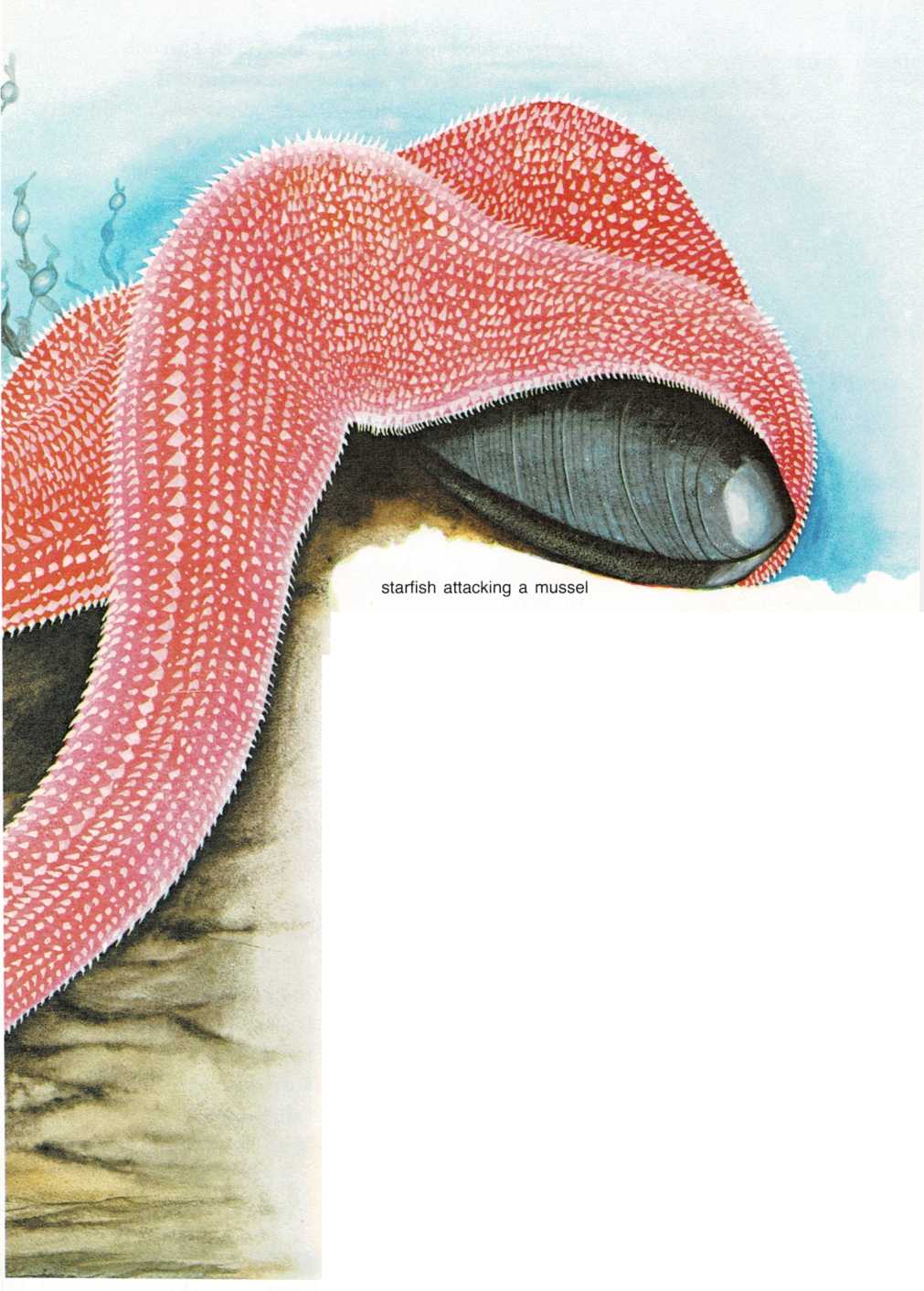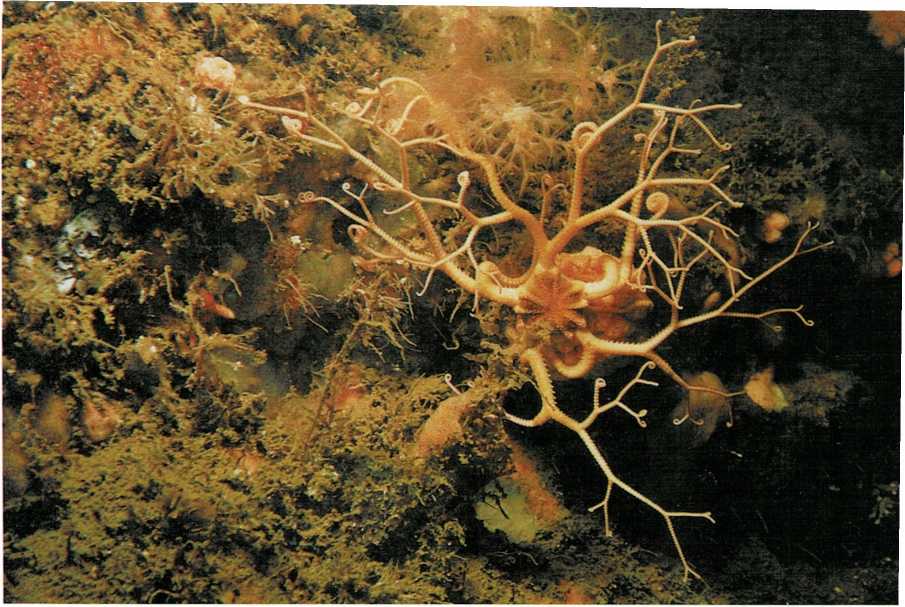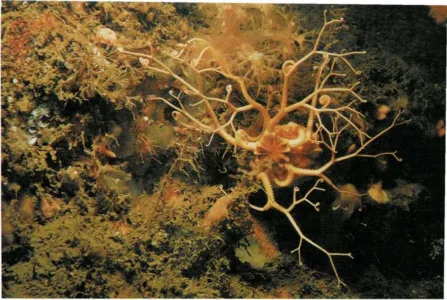Stars in the sea
A tiny, colorless ball floats near the surface of the sea. It is one of
several million eggs laid in the water by a common starfish.
Within three or four days, a soft-bodied creature hatches from the egg.
Like the egg, it is colorless. It looks a bit like a football, a
mushroom, and a long worm all wrapped up in a ragged sheet of clear
plastic! It swims by wiggling rows of little hairs on its body.
This baby starfish, called a larva [(lahr]{.smallcaps} vuh), becomes
part of the huge, drifting mass of plankton. It eats the microscopic
plants called diatoms. Millions of its brothers and sisters are eaten by
cod and other fish, but this little creature is lucky. It survives.
After about two months, the larva, now a little more than an inch (2.5
centimeters) in size, leaves the plankton. It sinks down to the sea
bottom and fastens itself to a rock.
Then, during a period of about twenty-four hours, it changes. Part of it
swells up, breaks off—and slowly crawls away! This crawling creature
looks somewhat like a five-pointed star. It is a tiny starfish, not
quite as big as a pinhead. What is left of the larva dies.
The young starfish begins a new life on the sea bottom. Much of the time
it simply lies on the sand. At other times, it creeps about in search of
food. Slowly, it grows bigger. Its five \”arms” become longer.
At the end of a year, the starfish is about two inches (5 cm) wide. When
it is full grown, it measures nearly a foot (30 cm) from the tip of one
arm to the tip of the opposite arm. Its body, which is reddish in color,
is covered 210

with rows of tiny, round, hard bumps. These bumps make the starfish’s
body so rough that few creatures care to try to eat it.
The starfish has an eye at the end of each arm. These eyes are small
reddish spots that are just able to sense light. The animal’s feet are
rows of little tubes on the underside of its arms. At the end of each
tube is a tiny suction disk. When the starfish “walks,” it stretches out
the little tubes on one of its arms. These stick to the sand or rock.
The starfish then pulls with its tubes to move forward a tiny bit. Of
course, this is a very slow way to walk.
The starfish finds its food mainly by means of smell. And now its sense
of smell tells it there is food on a nearby rock. The starfish creeps to
the rock and begins to climb it.
Attached to the top of the rock is a mussel—an animal that looks a bit
like an oyster or a clam. One of the starfish’s arms touches the mussel.
At once, the mussel closes its shell. But it is doomed! The starfish
crawls on top of it. Tube feet on all the starfish’s arms stick tight to
both halves of the mussel’s shell. Slowly, the starfish begins to pull
the shell open.
The mussel tries desperately to keep its shell closed, but it cannot.
The muscle that holds the two halves of the shell together grows tired.
The shell opens—just a tiny crack. But that’s enough for the starfish.
From an opening in the middle of the underside of its body, a little
sack pushes through the crack. This sack is actually the starfish’s
stomach! The stomach presses against the mussel’s body and slowly
digests it, until nothing is left!
There are about two thousand different kinds of starfish, or sea stars
as they are sometimes called. Sea star is actually a better name, for
these animals are not fish. They are echinoderms. Most kinds of starfish
have five arms, but some have seven, or eight, or a dozen, or as many as
fifty.
One kind of starfish is called a brittle star. It looks like a small
circle with five long snaky arms attached to it. Brittle stars are much
faster and more active than other kinds of starfish. Most of them move
by slithering along with powerful twists of their arms. Some can even
swim short distances.
Not all starfish begin life as floating eggs.

basket starfish
Some kinds, like a mother hen, \”sit” on their eggs till they hatch. And
some kinds keep the eggs in their bodies until the eggs hatch.
Starfish do not all eat the same things, or in the same way. Some
swallow tiny snails, and other shelled creatures whole. Some feed on the
soft little animals that live in coral. Some eat mud to get bits of dead
plants and animals. And some eat other starfish.
Many kinds of starfish are brightly colored. They may be red, pink,
purple, orange, green, or blue. Some are red with white spots, some are
pale blue with red and dark blue spots, and some are white with red
stripes.
One of the most interesting things about starfish is their ability to
grow new arms. If an arm, or part of an arm, is bitten off, a starfish
can grow a new one! In fact, if a starfish is torn in two, each part
will grow into a whole new starfish!

